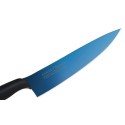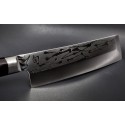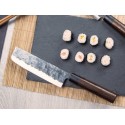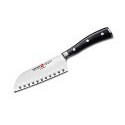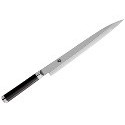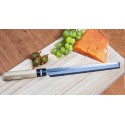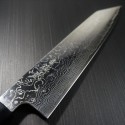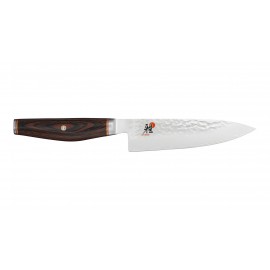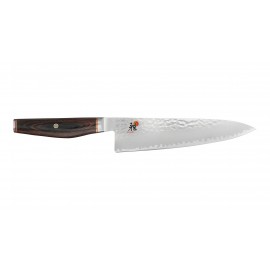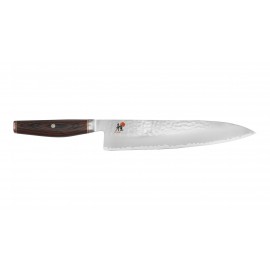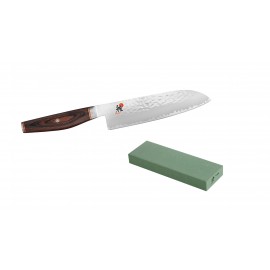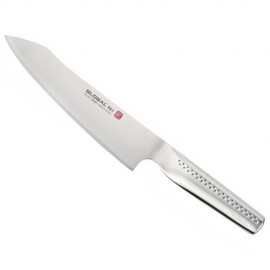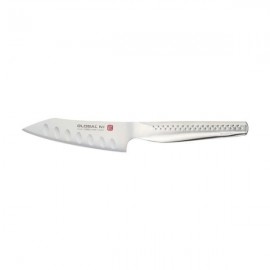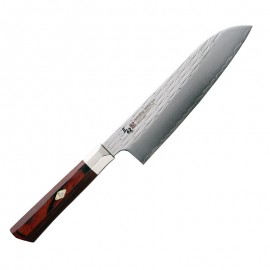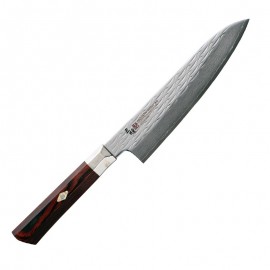Japanese knives represent the perfect balance between artisanal tradition, extreme precision, and elegant functionality. With centuries of history behind their craftsmanship, each knife is a masterpiece designed for clean, accurate cuts — elevating both professional and home cooking experiences.
In this section, you'll find a carefully curated ...
Japanese knives represent the perfect balance between artisanal tradition, extreme precision, and elegant functionality. With centuries of history behind their craftsmanship, each knife is a masterpiece designed for clean, accurate cuts — elevating both professional and home cooking experiences.
In this section, you'll find a carefully curated selection of high-end Japanese knives, forged with premium-quality steel and blades that retain their sharpness for longer. Some of the most iconic models include:
Santoku – versatile, perfect for meat, fish, and vegetables
Gyuto – the Japanese equivalent of a Western chef’s knife
Nakiri – ideal for precise vegetable cutting
Yanagiba – long and thin blade, perfect for sushi and sashimi
Petty – small and agile, great for precision work
Many of these knives are handmade by master craftsmen, featuring traditional wooden handles and designs that combine aesthetic beauty with professional functionality.
Whether you're a chef, a culinary enthusiast, or a collector, a Japanese knife is an investment in quality, durability, and unmatched performance.
Japanesse Knives There are 9 products.
Subcategories
Titanium Knives
The Kasumi Titanium knives, are made from vanadium, molibdenio and regarment of titanium. Allowing this way a good edge for the combination of the steel and the titanium. The knives kasumi titanium are presented in several colors of leaf: Blue, Gold and grey
Deba Knives
The Deba knife is a type of Japanese kitchen knife with a pointed blade used mainly to cut and clean fish, poultry and meat. It is perfect for heavy cutting task
Usuba Knives
The Usuba knife is the Japanese knife for vegetables, typically used by professionals. It also features a thinner blade compared to other Japanese knives or bochos. The Usuba knife has a single-beveled edge (though there are also left-handed versions), or sometimes a double bevel, although the original Japanese versions only have a single cutting edge.
In addition to being a thinner blade compared to other knives, it is lighter, but still lighter than the Nakiri knife, which is also a vegetable knife, though more commonly used in home kitchens. The base of the Usuba blade, the cutting edge, is straight or very slightly curved, allowing the entire surface to cover the vegetables or produce being cut.
Nakiri Knives
Nakiri Knife – Japanese Precision for Vegetables
The Nakiri knife is a traditional Japanese-style vegetable knife designed for effortless, clean cuts. With its straight, double-beveled blade, it’s ideal for chopping, slicing, and dicing all kinds of vegetables with precision and speed.
Key Features:
Blade shape: Flat edge with a squared-off tip, perfect for straight up-and-down chopping motions—no rocking required.
Typical length: Between 6.5" and 7" (16–18 cm).
Double bevel edge: Suitable for both right- and left-handed users, providing clean and symmetrical cuts.
Thin and lightweight: Reduces resistance, making it easy to cut thin slices or delicate julienne strips.
Common materials:
High-carbon stainless steel or traditional carbon steel (sharper but requires more maintenance).
Many models also feature Damascus steel for beauty and durability.
Ideal Uses:
Chopping and slicing all types of vegetables and fruits.
Perfect for precision work like shredding cabbage, julienning carrots, or slicing eggplant.
Not recommended for cutting bones, frozen foods, or hard-skinned produce.
Why Choose a Nakiri?
Ultra-sharp edge protects the integrity of your vegetables.
Cuts cleanly without crushing or tearing delicate produce.
Loved by both professional chefs and home cooks seeking a dedicated vegetable knife or interested in Japanese culinary tools.
Santoku Knives
Santoku knives are an essential tool in any kitchen seeking precision, versatility, and efficiency. Originating in Japan, the word "Santoku" means “three virtues,” referring to the knife’s ability to slice meat, fish, and vegetables with equal ease. With a balanced design, wide blade, and razor-sharp edge, the Santoku knife allows for smooth, accurate cuts with exceptional control and safety.
In our store, you'll find a curated selection of high-quality Santoku knives, perfect for both professional chefs and home cooking enthusiasts. We offer models crafted from premium stainless steel, Damascus steel, or traditional Japanese forged steel, with ergonomic handles made from wood, resin, or carbon fiber to suit every culinary style.
Each Santoku knife in our collection has been chosen for its durability, functionality, and refined craftsmanship. Whether you're just discovering the world of Japanese knives or looking to upgrade your kitchen gear, our Santoku knives provide the perfect balance of tradition, innovation, and performance.
Browse our collection and see why the Santoku knife has become a favorite in kitchens around the world.
Yanagiba Knives
Yanagiba Knives: The perfect choice for precise, professional cuts in Japanese cuisine. Originating from Japan, these knives are known for their long, slender blade, making them ideal for cutting raw fish, sashimi, and sushi with pinpoint accuracy. The sharp blade and Japanese craftsmanship combine to offer exceptional performance in preparing delicate dishes.
In our store, you’ll find a curated selection of Yanagiba knives made from forged Japanese steel, high-resistance stainless steel, and cutting-edge materials. Whether you're a professional chef or a cooking enthusiast, our Yanagiba knives are designed to provide clean cuts without damaging delicate ingredients.
Each Yanagiba knife in our collection has been carefully chosen for its durability, ergonomic design, and exceptional sharpness. With a handle that ensures a firm, comfortable grip, these knives are perfect for cutting whole fish, sashimi, sushi, and other delicate ingredients with ease.
Key Features of Yanagiba Knives:
Precise cuts: Ideal for making fine, detailed cuts in fish and sushi.
High-quality material: Made from forged Japanese steel or high-performance stainless steel.
Ergonomic design: Comfortable handle for a secure and balanced grip.
Versatility: Perfect for professional chefs and Japanese cuisine enthusiasts.
Explore our selection of Yanagiba knives and see why they’re an essential tool in expert kitchens. Whether you’re looking for a knife for sashimi, sushi, or general fish cuts, our Yanagiba knives will provide the precision and performance you need.
Shop high-quality Yanagiba knives online and take your Japanese cooking to the next level.
Takohiki Knives
Takihiki knife is a Japanese slicing knife with a square tip. Designed to cut octopus (Tako in Japanese), sushi and sashimi.
Kiritsuke Knife
Japanese Kiritsuke Knives are high-end kitchen tools with a unique history and design, known for their elegance and versatility. Originally used by top chefs in Japan, the Kiritsuke knife is highly valued in professional kitchens for its precise cuts and sharpness.
Features of the Kiritsuke Knife:
Design: The Kiritsuke knife has a long, sleek shape with a sharp, slightly curved tip. The blade is thick near the base, providing stability, and tapers towards the edge, offering excellent cutting ability.
Versatility: Although the Kiritsuke is often associated with Japanese cuisine, it is an extremely versatile knife that can be used for both cutting meat and vegetables. It is primarily used for slicing, filleting, and chopping. Often considered a hybrid between a chef’s knife and a sashimi knife, it excels at making fine and precise cuts.
Edge: Kiritsuke knives typically feature a single-beveled edge (sharpened on one side), allowing for finer and more precise cuts compared to double-beveled knives. However, there are also double-beveled versions for greater versatility. The single bevel is more traditional, especially in Eastern versions.
Size: Typically, Kiritsuke knives range from 24 to 30 cm. They are longer than traditional chef’s knives, allowing for longer, more delicate cuts.
Traditional Use: In Japanese cuisine, the Kiritsuke knife has a dual purpose: used both for cutting ingredients for dishes and for the presentation of sashimi and sushi. Its tapered blade allows for extremely precise cuts, which are crucial for the presentation of refined dishes.
Advantages of the Kiritsuke Knife:
Precise, clean cuts: The sharp edge and blade shape enable extremely precise and clean cuts, which are especially important when handling delicate ingredients such as fish or vegetables.
Aesthetic: Besides its functionality, the design of the Kiritsuke is visually attractive, making it a prized tool for chefs who value the beauty of their kitchen tools.
Durability: Kiritsuke knives are made from high-quality materials like Japanese stainless steel or Damascus steel, giving them long-lasting sharpness and excellent cutting performance.
Recommended Uses:
Vegetables and Fish: Due to its precision, the Kiritsuke is perfect for slicing vegetables into fine rounds or juliennes and for filleting fish in a precise and uniform manner.
Meats and Boning: It is also used for meat, though its more delicate form makes it less suitable for cutting through bones or very thick meats.
MIYABI 6000MCT Japanesse Gyutoh Knife 16 cm
MIYABI 6000MCT Japanesse Gyutoh Knife 16 cm. Miyabi's Gyutoh Japanese knife is designed for slicing, slicing meat and fish. Micro Carbide MC63, Tsuchime, 3-ply powder steel blade. Pakka cocobolo wood handle + stainless steel, ergonomic.
204,00 €In StockMIYABI 6000MCT Japanesse Gyutoh Knife 20 cm
MIYABI 6000MCT Japanesse Gyutoh Knife 20 cm. Miyabi's Gyutoh Japanese knife is designed for slicing, slicing meat and fish. Micro Carbide MC63, Tsuchime, 3-ply powder steel blade. Pakka cocobolo wood handle + stainless steel, ergonomic.
234,00 €In StockMIYABI 6000MCT Japanesse Gyutoh Knife 24 cm
MIYABI 6000MCT Japanesse Gyutoh Knife 24 cm. Miyabi's Gyutoh Japanese knife is designed for slicing, slicing meat and fish. Micro Carbide MC63, Tsuchime, 3-ply powder steel blade. Pakka cocobolo wood handle + stainless steel, ergonomic.
274,00 €In StockMIYABI 6000MCT Japanesse Santoku Knife 18 cm
MIYABI 6000MCT Japanesse Santoku Knife 18 cm. Miyabi's Gyutoh Japanese knife is designed for slicing, slicing meat and fish. Micro Carbide MC63, Tsuchime, 3-ply powder steel blade. Pakka cocobolo wood handle + stainless steel, ergonomic.
219,00 €In StockMIYABI 6000MCT Japanesse Santoku Knife 18 cm + WaterStone 400
MIYABI 6000MCT Japanesse Santoku Knife 18 cm + WaterStone 400. Miyabi's Gyutoh Japanese knife is designed for slicing, slicing meat and fish. Micro Carbide MC63, Tsuchime, 3-ply powder steel blade. Pakka cocobolo wood handle + stainless steel, ergonomic.
323,00 €In StockGLOBAL NI GN-009 Kiritsuke Chef Knife 20 cm
GLOBAL NI GN-009 Kiritsuke Chef's knife 20 cm, Japanese chef's knife model Kiritsuke GLOBAL NI in stainless steel with chrome alloy. Sheet size 20 cm.
133,95 €In StockGlobal GNS-01 11cm Oriental Cooks Knife 11 cm
Global NI GNS-01 Oriental Cooks Knife 11 cm, Japanese cooks knife GLOBAL NI in stainless steel with chrome alloy. Sheet size 11 cm.
114,00 €In StockMCusta Santoku Knife Supreme Ripple 180 mm - TZ2-4003DR
Japanese Santoku Zanmai MCusta knife with 180 mm blade and 324 mm total length. It is made of 33-layer damascus steel and a VG-10 steel core. With traditional octagonal red wood handle and decorative mosaic pin.
189,95 €Out of stockMCusta TZ2-4005DR Gyuto Knife Supreme Ripple 210 mm
Japanese Gyuto Zanmai MCusta knife with 210 mm blade and 353 mm total length. It is made of 33-layer damascus steel and a VG-10 steel core. With traditional octagonal red wood handle and decorative mosaic pin.
209,95 €In Stock

